
Mac Treks and Tours Nepal Pvt. Ltd.
J.P. Road, Chhetrapati, Kathmandu, Nepal
Loading Nepal Time...
Our Services
- Great Himalayan Trails Popular
- Trekking in Nepal
- Nepal, Tibet and Bhutan Tours
- Helicopter Tours and Rescue Popular
- Logistics arrangements for all treks and tours
Contact Information
Location Map
Company Information
Company Registration: 103002
Tax (PAN) Number: 500152935
Tourism Registration: 313